When the odds are against you, Andrew Apsey describes a fishing adventure on the Irfon River in Wales, spot the hidden trout, Andre van Wyk on fishing the Elandspad, fishing the whisky streams of the Western Cape from Greg Carstens and more…
The weather forecast for Thursday’s fishing last week was poor, but Robin Douglas and I went out anyway and ended up fishing a rising river in wind and rain. Apart from two fish that flashed at my nymph we saw nothing and headed out after an hour or two, cold and wet but not despondent.
The riverside was a garden of colourful fynbos and we spent some time taken images of the flowers and of lichen, two species living side by side on the same boulder, one blood red, the other orange.
Click in images to enlarge
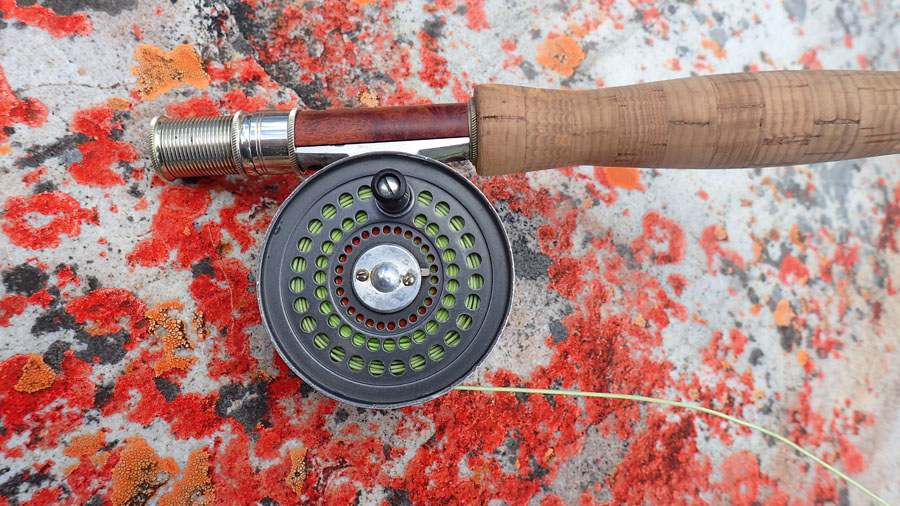
From the British Lichen Society website I learned that lichen is not a single organism; it is a stable symbiotic association between a fungus and algae. Like all fungi, lichen requires carbon as a food source; this is provided by their symbiotic algae that are photosynthetic. The lichen symbiosis is thought to be a mutualism, since both the fungi and its photosynthetic partner benefit.
As for the fynbos, it was out of this world.
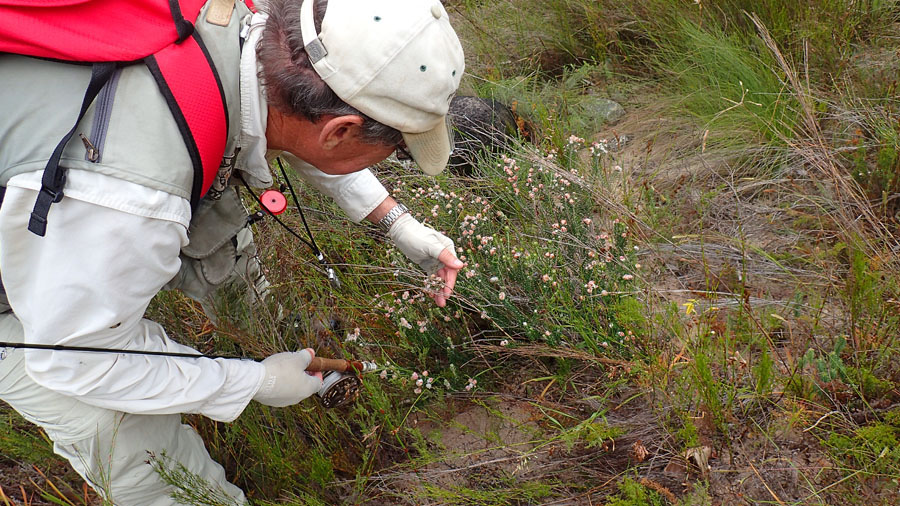
Robin Douglas examines a tiny aspect of the world's biggest floral biome
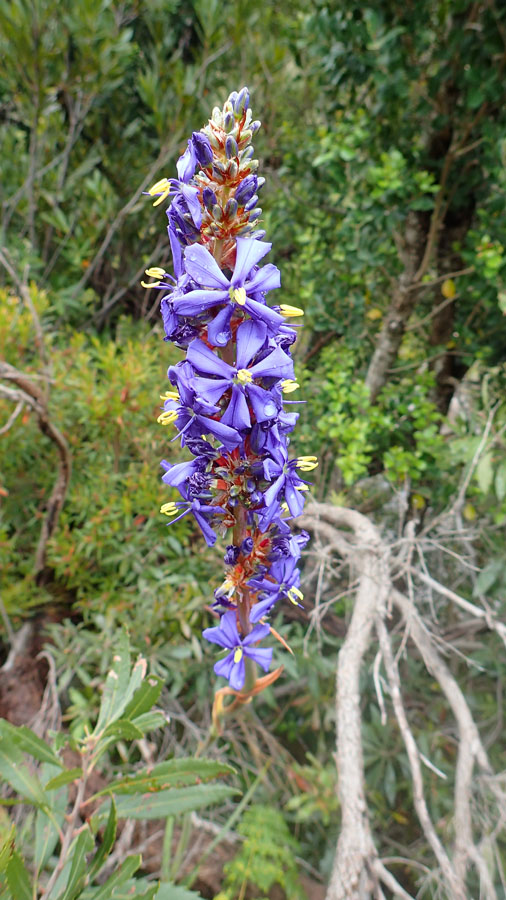
I think this is the ‘Blue Lady’s Hand’ (Cyanella hyacinthoides)
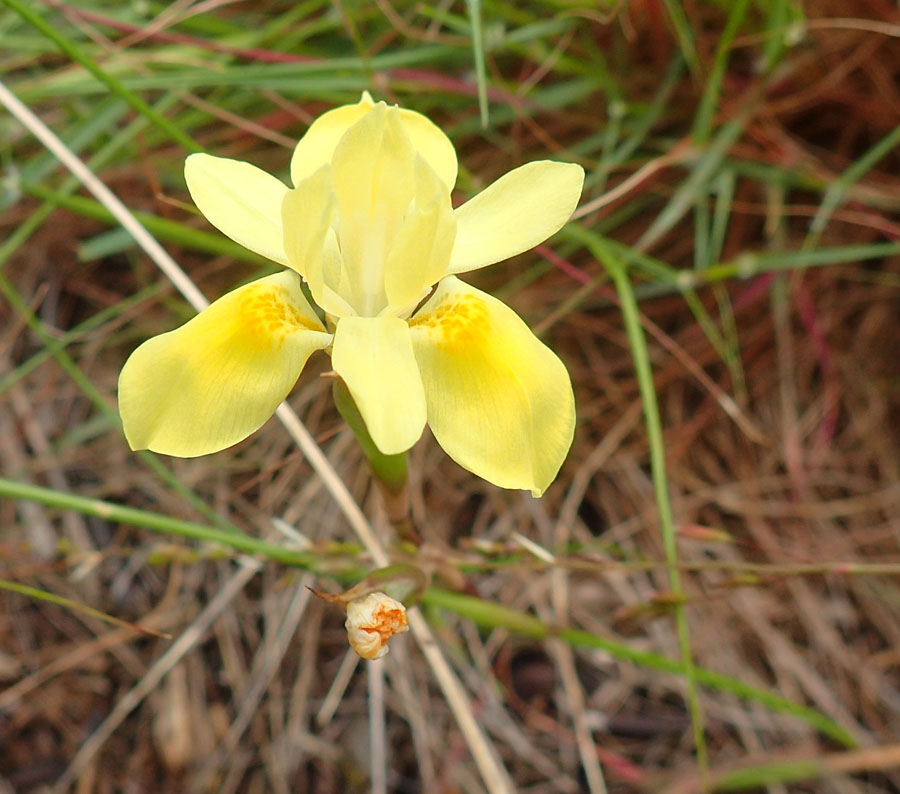
And this (again, I think) is a yellow Morea Iris
Crossing the stream to get back to the truck the water level was palpably higher and the flow stronger and I ended up wet to the waist. But it at least afforded an opportunity to photograph some sub-aquatic bugs I would probably have otherwise missed.
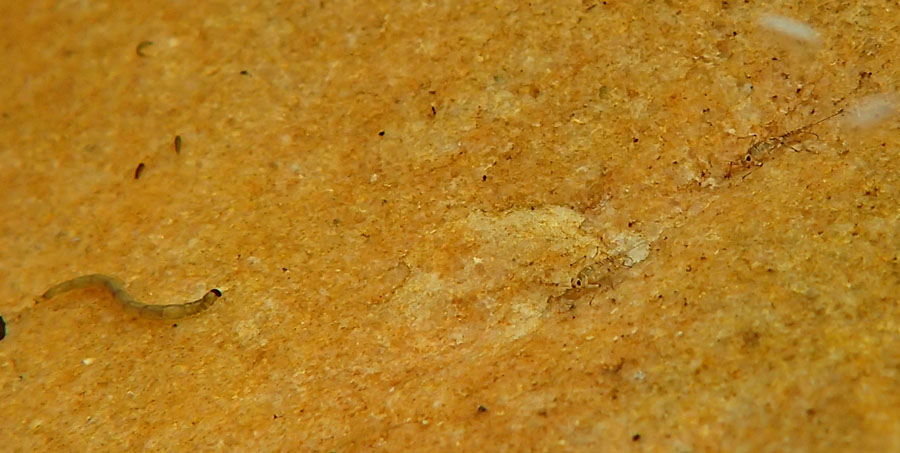
In the image above a green chironomid larva (left) and to the right, two very well-camouflaged stone-clinging mayfly nymphs are eventually easily discernible
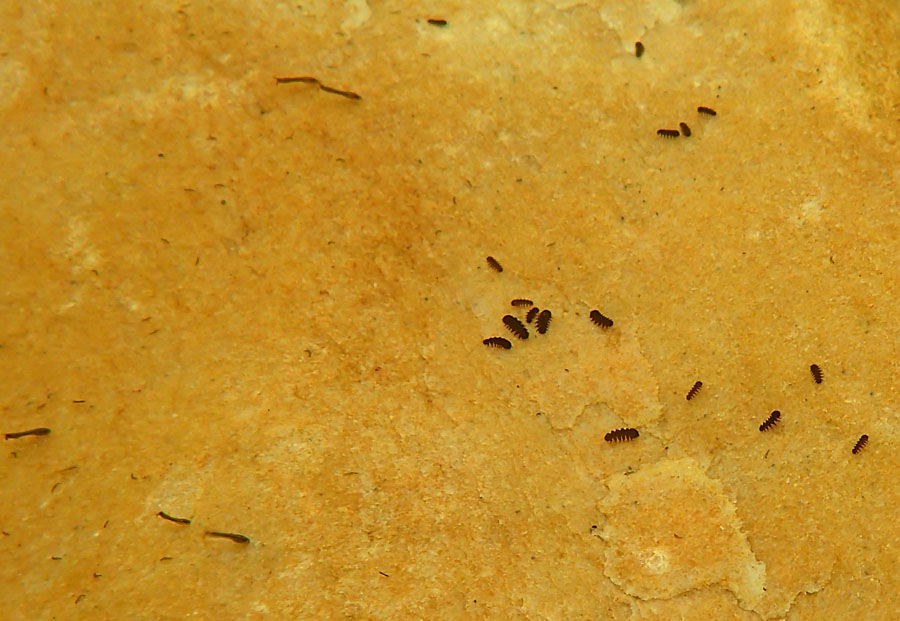
This rock is teaming with the clearly segmented larvae of the mountain or net-veined midge which attach to the rocks through ventral suckers. Also in the image are black fly larvae that look like little black exclamation marks!
As for our lack of trout, well we’ve arranged a return match this week on Tuesday when the weather is predicted to be hot and clear when we will no doubt even a few scores.
Andrew Apsey describes a fishing adventure on the Irfon River in Wales
Andrew fished two lovely beats of this river over four days and I posted his story and images on my website this week
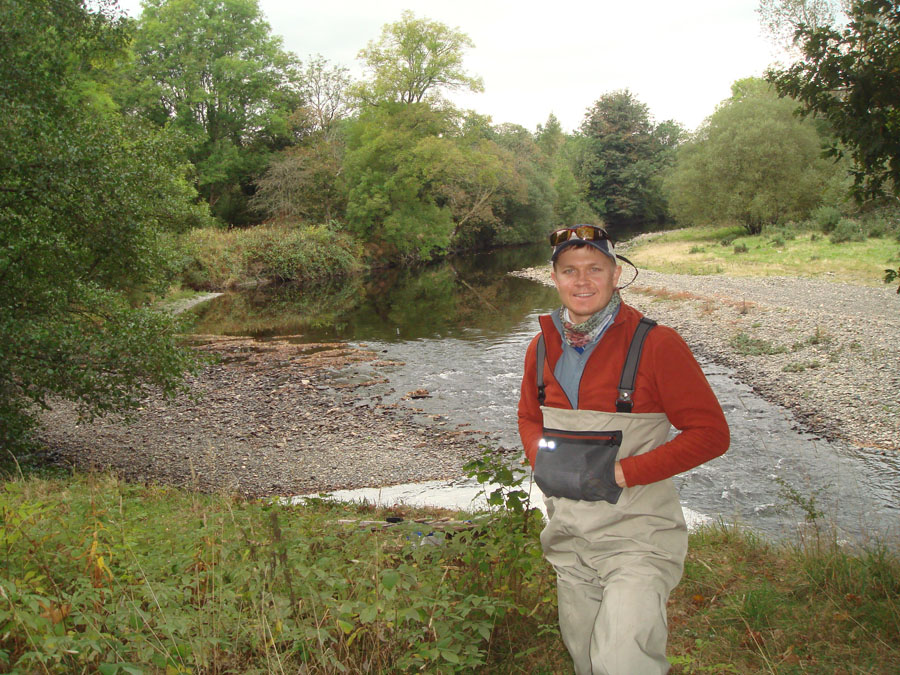
Andrew Apsey on the Irfon in Wales
http://www.tomsutcliffe.co.za/fly-fishing/friend-s-articles/item/965-welsh-fly-fishing-adventure-by-andrew-apsey.html
Spot the trout
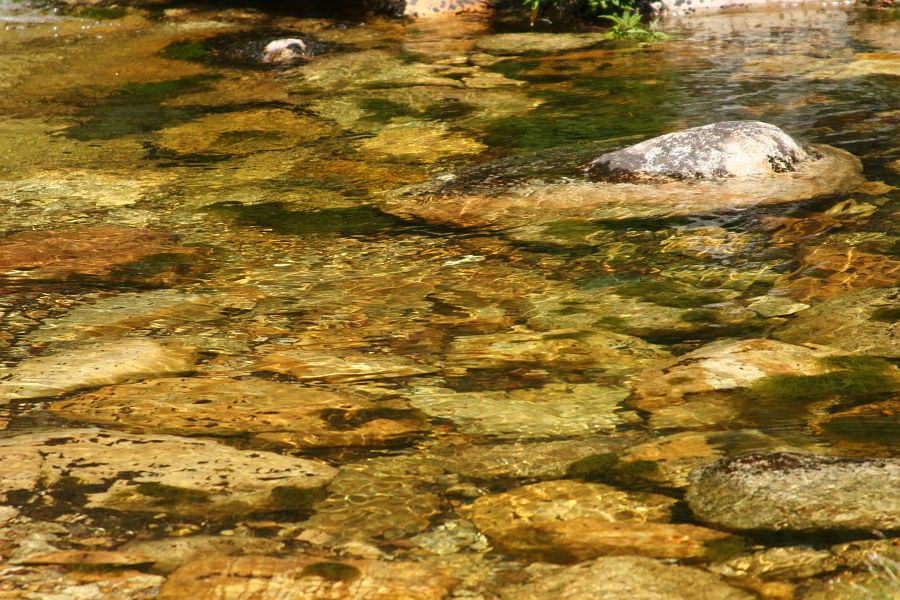
Answer at end of the newsletter
From Andre van Wyk on fishing the Elandspad
I’ve had a great last two months in that I’ve been lucky enough to spend two weeks in the Caribbean, Grand Cayman to be exact, where I lived for five years, so have friends who we stayed with. Granted it’s no fishing mecca, but it was great to successfully chase bonefish again, and have some fantastic back country juvenile Tarpon fishing on the 3-weights (yes I know, sounds nuts, but actually the perfect weapon for the situation and the fish!). And then I was lucky enough to spend 10 days in Southern Oman chasing truly Jurassic park style critters. Without a doubt, this is the richest piece of ocean I’ve ever come across in my many travels. It’s quite staggering and has to be seen and experienced to believe, but that is a tale for another day.
My reason for writing is to share with you a very special fish for me, which I took this past Sunday whilst fishing my first day of the Stream season, up on Elandspad, Beat 4. EP4 has long been a favourite of mine, for its remoteness, its beauty, and if I’m honest, its wonderfully willing fish, which on a good day can make you feel like a better angler than one probably is; a lovely early season beat to work out the kinks, and the hike in helps shed some of winters culinary excess too.
But one thing it’s never been for me is about big fish. Sure one comes across a good number of 12” fish with a few now and then going northwards of that, and while I know there are bigger fish up there, I’ve seldom tangled with anything north of 14”.

Andre Van Wyk – Does it get any better?
That changed on Sunday when I had the blessed fortune of crossing paths with this wonderful fish. I didn’t measure it, and as always, the pictures never seem to do a fish justice and being a big guy with big hands doesn’t help, but it dwarfed anything I’ve previously ever seen on the streams, let alone hooked.
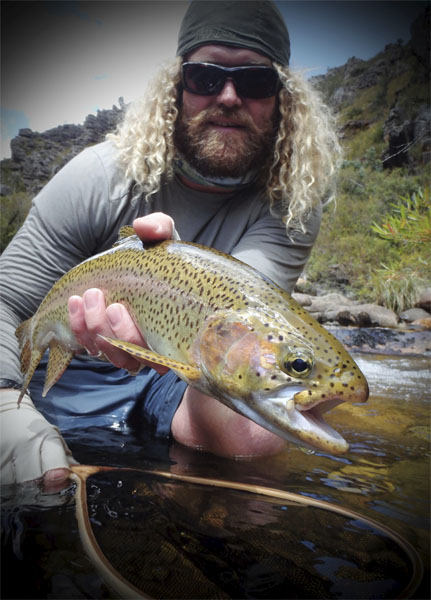
An understandably ‘giddy’ angler
I was giddy after finally getting her in the net, and it took a good 15 minutes for me to return to a “functional” angler afterwards. It smashed my personal best by a long way which was taken on the Jan du Toit’s in May, which you featured in your newsletter, that my friend and fishing buddy Platon Trakoshis forwarded on to you.
From Peter Brigg in KZN
I wanted to send a few pictures taken recently on a couple of outings I have had to the Bushman’s up at Giants Castle and the other to the Polela at Cobham in the southern Berg for interest. I fished the Bushman’s, but only because it was an outing with my two of the grandsons who had been looking forward to the fishing for a couple of weeks. The system is so fragile at the moment with paper thin, gin clear water. The browns are as pretty as ever, but as skittish as hell as you can imagine.
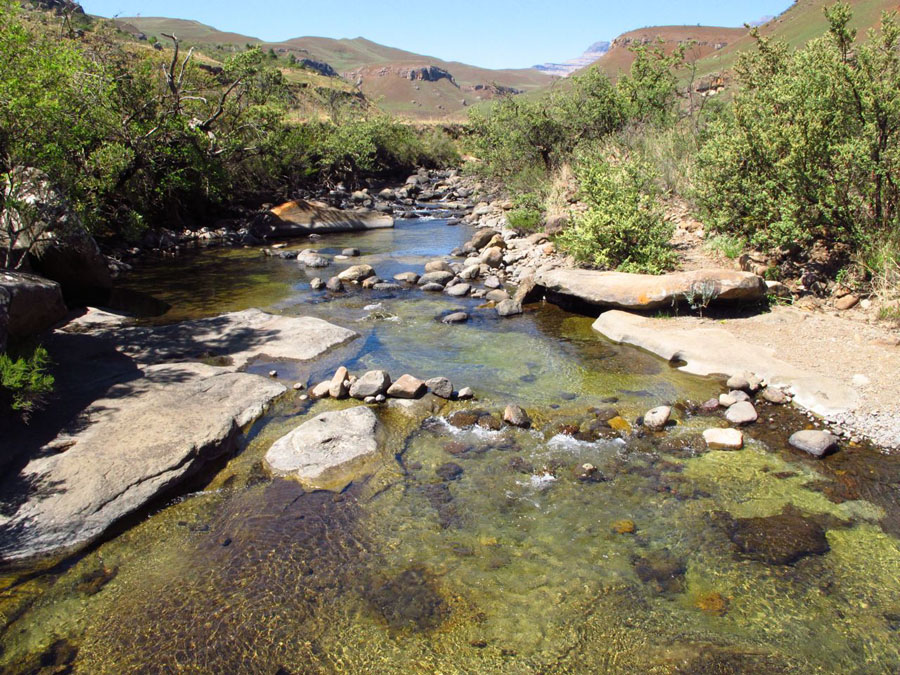
The Bushman's
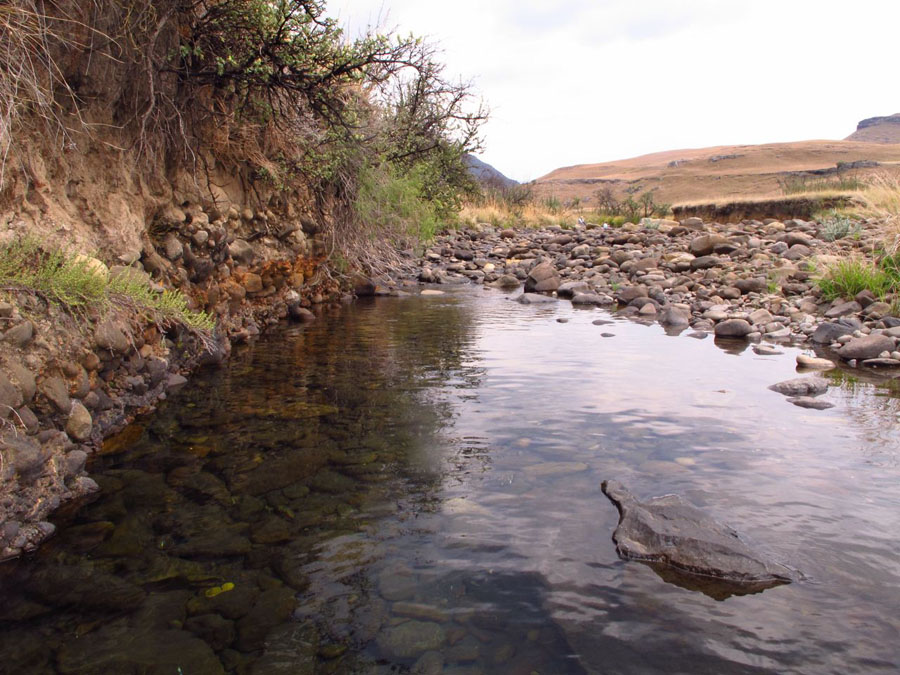
The Polelea
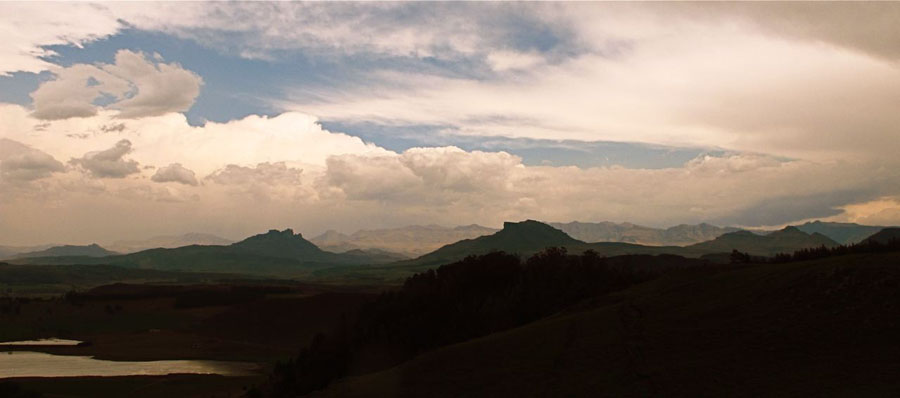
The approaching storm
The second outing was to the Polela and here I didn’t even consider taking my Boshoff bamboo out of its tube. All the rivers under the UHTF Club are currently closed because of the conditions so the Polela was my only option in the Parks Board area – the pictures will tell the sad state of the mountain streams at the moment. I took a walk along the stream and spotted only a single four inch trout. In the late afternoon a storm swept across the mountains and dumped a fair amount of rain. Regrettably, much of it was simply sucked up by the dry ground with little change to the flows, but it may herald a change in the current dry weather pattern.
I don’t ever recall a spring as dry as this one.
(Pete recommends that anglers don’t fish the Bushman’s until the water levels have risen as the trout are at risk right now.)
Then and now
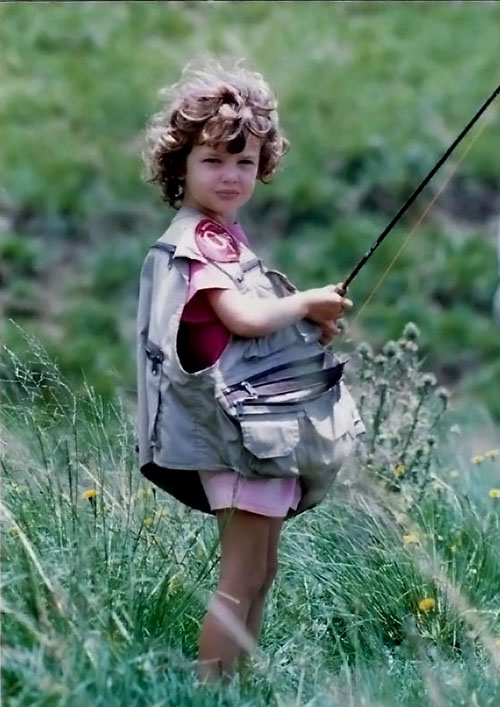
My daughter Alison aged three and a half
On the 13th of this month my daughter Alison celebrated her 28th birthday. As a father, just like a kid with a new fly rod, I think I have every excuse to be very proud of her and to be forgiven my mild flirtation with immodesty by including her in my newsletter.

And as she looks today
Fly tier Gordon Van der Spuy says…
I have just brought in a batch of lightweight, high quality fly tying scissors from Japan, those KAI scissors I use. Have a limited supply so mail me if you are interested. I also have some great biots that I just got in. They're extra long. Specify however if you want small or large. Small will tie 20s and 18s with ease. The large will tie right up to size 10. Also have a load of turkey tail pairs, great for wing cases on things like dragonfly nymphs.
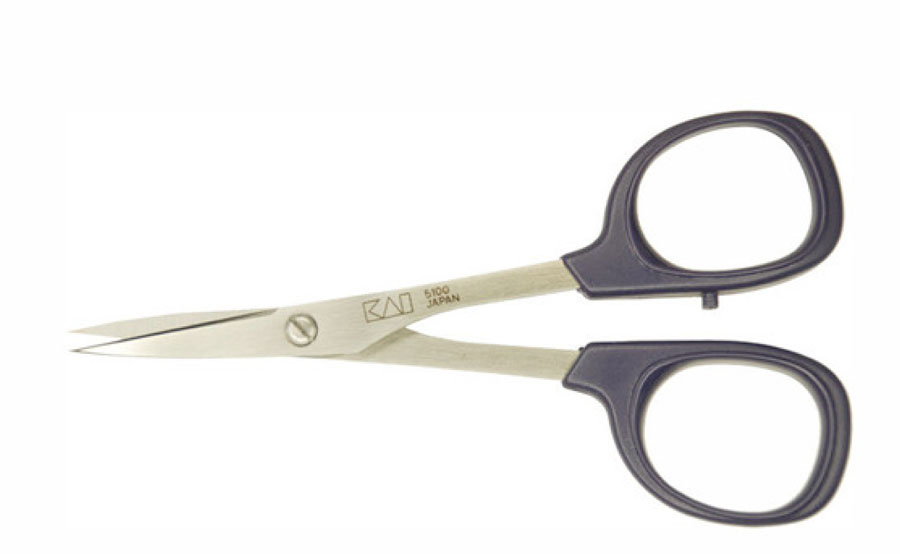
The Kai scissors retail for R250 a pair, the best scissors I've ever owned. The biots retail for R35 a packet and I guarantee these are the best biots you've ever tied with. The turkey tails retail for R50 a pair. They are not super A grade, but at the price they're a bargain. Will also be getting full squirrel skins in soon, as well as rabbit skins.
Contact Gordon Van der Spuy at This email address is being protected from spambots. You need JavaScript enabled to view it.">This email address is being protected from spambots. You need JavaScript enabled to view it.
Appeal from Peter Brigg
Peter, who together with Joan Wulff, has negotiated a South African fly fishing exhibit to feature in the Catskill Fly Fishing Center and Museum (CFFCM) writes:
The progress accumulating material for the fly fishing exhibition to be held early next year at the Catskill Fly Fishing Centre and Museum in the USA to showcase what South Africa has to offer the wider fly fishing community, has been slower than expected. There have been many positive responses, but far less in concrete participation. In an attempt to strengthen the material to make this a worthwhile exercise, I have extended the deadline for submission to the 15 November 2014. I accordingly, make an appeal to all of those that have already been approached and who have not yet sent in the details and information requested, your input will be greatly appreciated. In particular, I appeal to the Clubs, guides, fly tyers and craftsmen who have been approached and if by any chance I have missed anyone, my apologies, you are welcome to contact me at This email address is being protected from spambots. You need JavaScript enabled to view it.">This email address is being protected from spambots. You need JavaScript enabled to view it. and I will let you have all the relevant information.
This exhibition will provided a wonderful opportunity to introduce SA fly fishing to a captive audience at the CFFCM, not just Americans, but from around the world who visit the Centre and through their website, social media and newsletter that are currently mailed to over 8000 recipients worldwide. In advance of the exhibition I have already contributed a paragraph or two to the CFFCM newsletter and have been asked to continue this throughout 2015. The material making up the exhibition will be retained by the Centre some displayed in their museum and other used from time to time in displays. So this is not just a one off, it will in the various forms mentioned, continue to showcase and benefit SA’s fly fishing in all respects. See more about the CFFCM at - http://www.catskillflyfishing.org/exhibits/”
Fishing the whisky streams of the Western Cape from Greg Carstens
In some regions you have to look for the beauty in your surrounds and slowly it reveals itself, but the Western Cape streams are incredibly beautiful from the outset. So when the opportunity opened up for some business combined with travel to the fair Cape with my wife and youngest daughter in tow we couldn’t make for Lanseria airport fast enough.
I have spent the last couple of years bouncing around Rhodes and surrounds, loving the time on each stream and the vast remoteness they offer, but of late the flows have either been low or flooding, leaving me fairly desperate for a simple day on a stream with moderate flows, clear water and the odd free rising trout.
I imagine the beats of the Smalblaar I booked were around a kilometre or so in length, but I could be a little mistaken. Up in Rhodes we book four or five kilometre stretches and often cover them in a day and although the Cape streams see more foot traffic than those in Rhodes, they are far more rugged, with very little by way of foot paths and mostly you move up the stream over loose boulder-sized rocks that faintly remind me of wading the Vaal. Footing is not guaranteed, so you just can’t cover as much ground and I suspect to cover more than a beat in a day requires a good set of wings. In places the stream width offers multiple lies and to be effective means many careful casts, constant awareness and gentle wading.
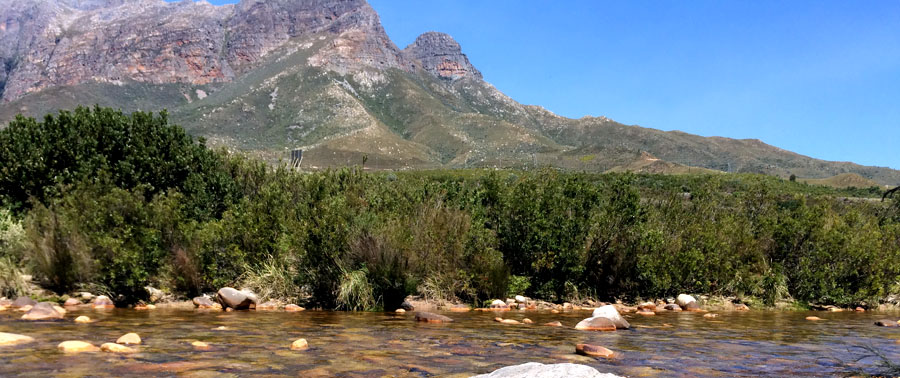
This was only my second visit to the Smalblaar and filled with a little apprehension I tried not to cast until I found a free rising fish, I walked past a slower pool and picked up some shadows on the streambed. The sun was high and I’d leave them until later.
A splashy rise caught my eye in the next lie and I moved forward, then another rise. To conceal my approach I stuck close to the edge and positioned myself to cast up and across. Yet another rise. I dropped my Adams on the mark and watched painfully as it drifted by. A few casts later I changed flies, shifting up to a RAB, hoping that I hadn’t put the fish down. A few casts later I switched down to a size 20 Adams as the fish rose once again, but it drifted through the run untouched. There was a gentle upstream breeze and I was finding my 6’9 1—weight, perhaps a little light and short for the fishing at hand.
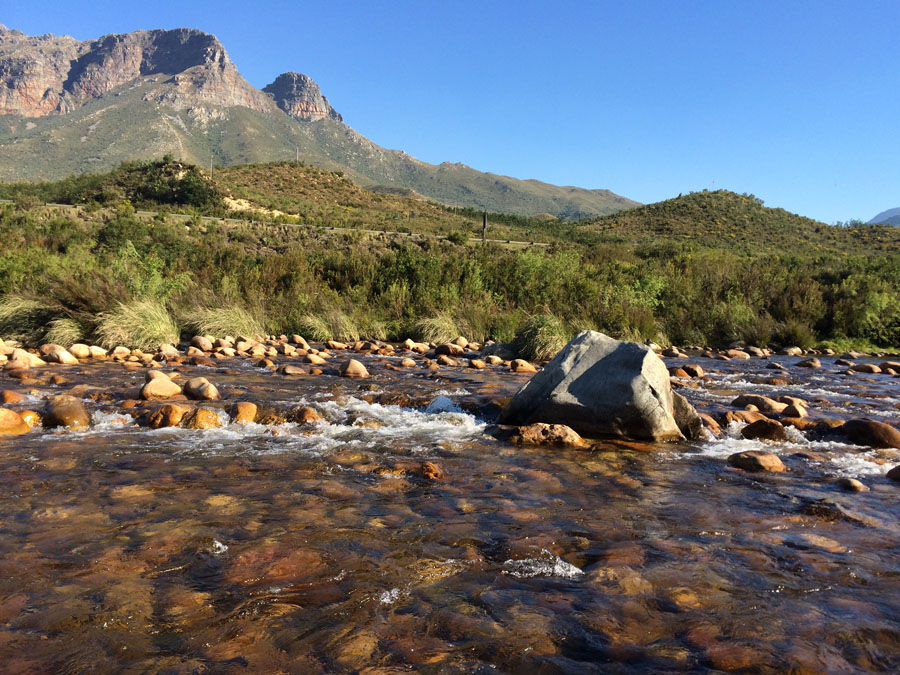
I took a break and switched over to a size 18 orange bead ZAK. The rising began again and I tested the lie with a not so good a cast. The fly drifted and I let it pass me lingering in the bubble line. It stopped and I struck into a powerful fish that seemed unsure that it was hooked. The fish was big but surprisingly she didn’t run and I managed to get her closer until she lay in my hand, a beautiful brown, the kind of stream fish that is rarely caught in South Africa and I was over the moon. I quickly posed her for a photo and she finned back to her deeper lie, almost like a professional that does this regularly, the whole episode seeming a little surreal.
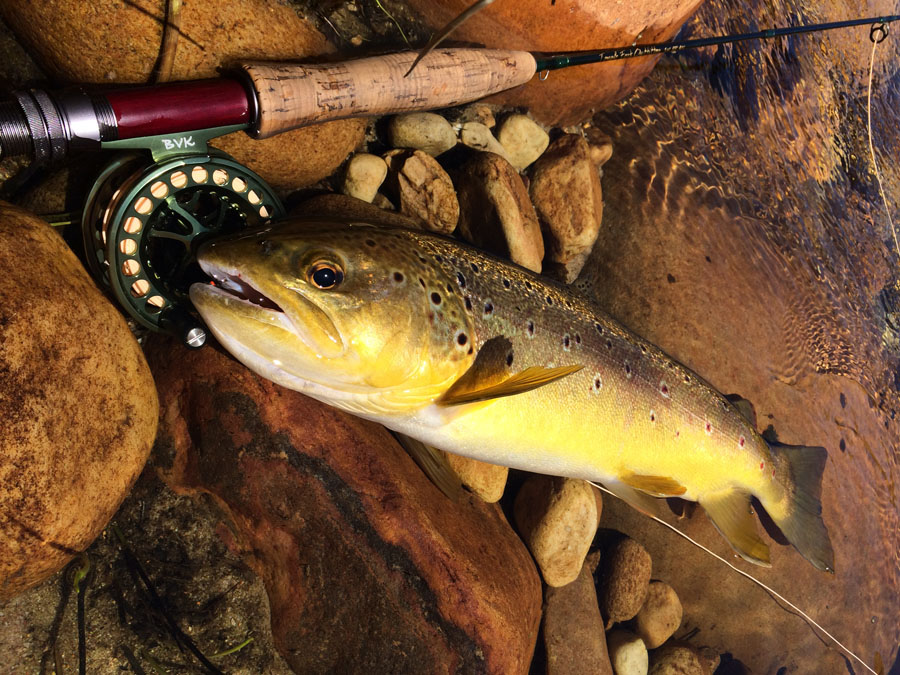
Isn’t it remarkable how just one fish can make all of the travelling, rushing around and effort so worth it? This lovely lady brown had set the tone for the rest of my trip and from here on out my approach was relaxed and I had a fulfilled feeling that’s hard to come by in this day and age.
I took a couple of rainbows up to 15 inches as I moved upstream on the ZAK. They fought incredibly hard, teaching my reel to sing new tunes. Further up I came upon a rising rainbow that was epic in size, with a tail easily the size of my outstretched hand. It was holding a prime lie, under overhanging brush in a patch of shade that was on the main seam of water and slowly taking tiny mayflies. This was the kind of fish that has lived through more than a few seasons, the kind of fish that local anglers probably have a name for, know about and it has probably been stung a couple of times by the better anglers. Would it be too much to ask? Seemed so. After 40 minutes and a half a dozen fly changes I gave the fish my best wishes and moved on.
I had to work hard to make my exit point by sunset and rushed over lots of great water, all in all the day was enchanting. The next day, Sunday, proved no different with a handful of feisty and surprisingly big rainbows testing my wits more than once. I fished a dry dropper setup that proved the business after trying to figure what the fish preferred and in the end I simply went for both.
The fishing had been sublime. The whisky streams showered me with memories and fish that matched the best I have seen.
Quote of the week
This is a piece from Ernest Hemingway, written for the Toronto Star Weekly, August 28, 1920. Although Hemmingway won’t divulge the name of the river, it is near the Soo River in British Columbia. He describes the fishing in it as ‘a wild nightmare kind of fishing , second only to angling for tuna off Catalina Island.’ Here’s an extract:
We decided on the McGinty and a Royal Coachman for the flies and the second cast there was a swirl like the explosion of a depth bomb, the line went taut and the rainbow shot two feet out of the water. He tore down the pool and the line went out until the core of the reel showed. He jumped and each time he shot into the air we lowered the rod and prayed. Finally he jumped and the line went slack and Jacques reeled in. We though he was gone and then he jumped right under our faces. He had shot upstream towards us so fast that it looked as though he were off.
When I finally netted him and rushed up the bank and could feel his huge strength in the tremendous muscular jerks he made when I held him flat against the bank, it was almost dark. He measured twenty-six inches and weighed nine pounds and seven ounces.
That is rainbow trout fishing.
From the book Hemingway on Fishing edited by Nick Lyons. Lyons Press 2007.
Images of the week

Wild rainbow in a Cape stream. Tom Sutcliffe image, 2009
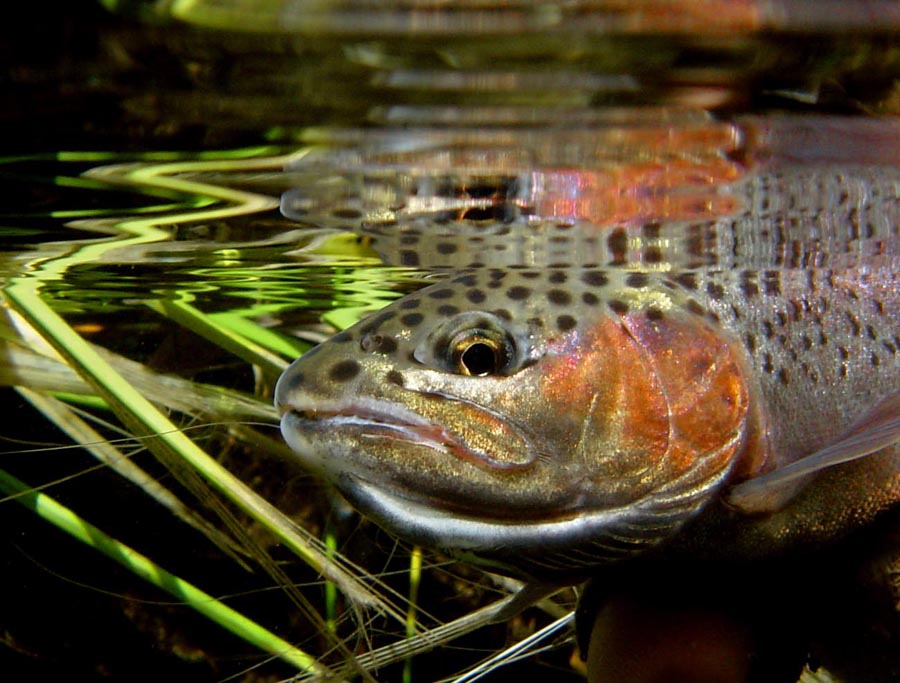
Rainbow in the Bell River near Rhodes. Chris Bladen image, 2006.
The answer to spot the trout
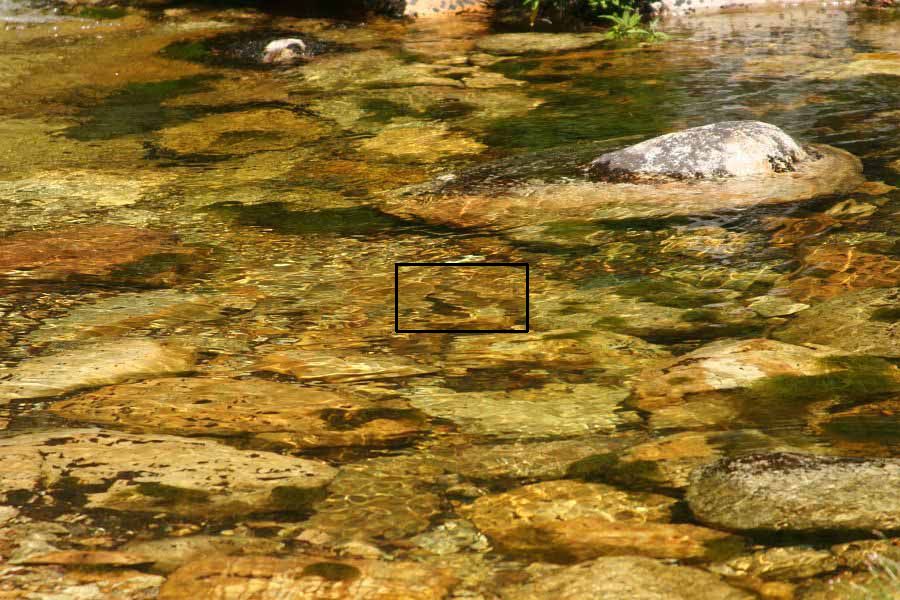
Here the trout is framed and if you look directly below and slightly ahead of it you will see the tell tale shadow on the stream bed
Tom Sutcliffe



